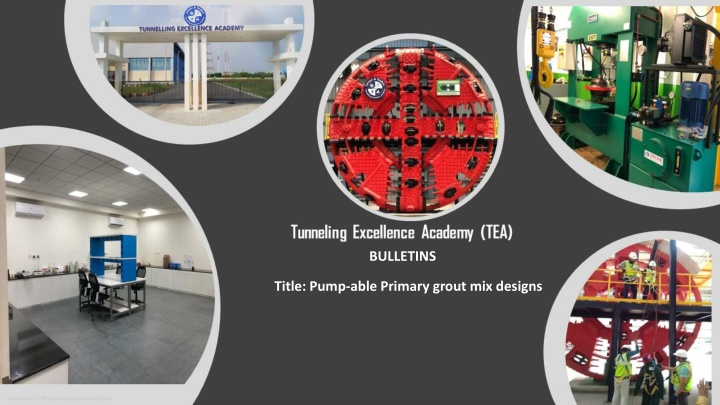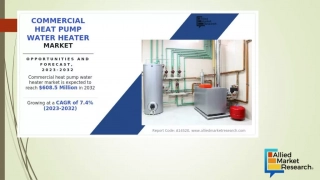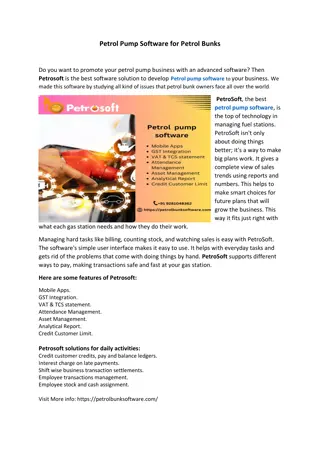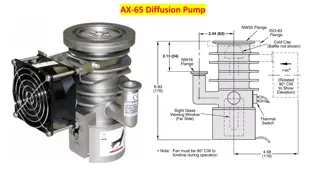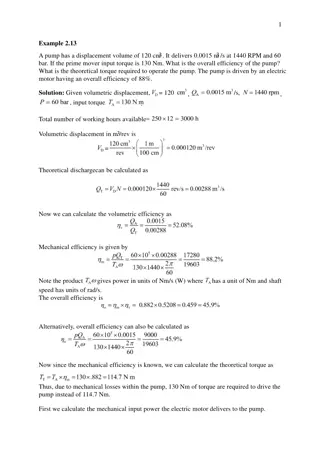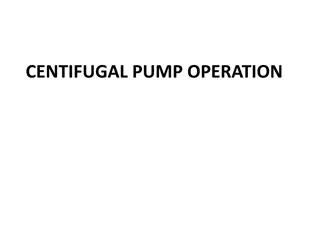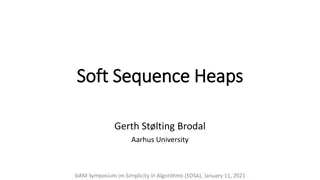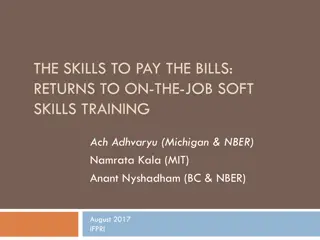A Comprehensive Guide to Pump-able Primary Grout Mix Designs for Soft Ground Tunnelling Operations
This detailed guide covers the grouting technique used in soft ground tunnelling operations, focusing on stabilizing tunnel segments and reducing ground settlement by filling annular spaces with different types of grouts. It includes information on laboratory tests, trial mix designs, technical requirements, and the evaluation of raw materials for TBM primary backfill grout. Monitoring tests such as marsh funnel viscosity, bleed and segregation, gel strength, and compressive strengths are outlined for internal construction use at LNT Construction.
Download Presentation

Please find below an Image/Link to download the presentation.
The content on the website is provided AS IS for your information and personal use only. It may not be sold, licensed, or shared on other websites without obtaining consent from the author.If you encounter any issues during the download, it is possible that the publisher has removed the file from their server.
You are allowed to download the files provided on this website for personal or commercial use, subject to the condition that they are used lawfully. All files are the property of their respective owners.
The content on the website is provided AS IS for your information and personal use only. It may not be sold, licensed, or shared on other websites without obtaining consent from the author.
E N D
Presentation Transcript
BULLETINS Title: Pump-able Primary grout mix designs Sensitivity: LNT Construction Internal Use Sensitivity: LNT Construction Internal Use
Pump-able Primary grout mix designs A & B components This Bulletin is Consist of Grouting Technique for soft ground tunnelling operations, tail voids are created as the TBM advances ahead of the segmental lining. These tail voids result from the cutting diameter of the TBM being larger than the outer diameter of the concrete segments. In order to stabilize the segments and reduce ground settlement, this annular space needs to be filled as the TBM advances. There are two basic types of annular grouts currently in use: thick mortar type grouts and highly mobile two-component grouts. Two-component grouts consist of an A and B component and are also referred to as Bi-Component or A/B Type grouts. The A-Component is a stabilized grout containing varied combinations of water, binders, bentonite (usually), and admixtures. The B-Component is a liquid accelerator that is added to the A-Component as it is being injected into the annulus. In this module we are covered Different Dosages of Cement content Trial Mix 1. Cement Content : 225 kg/m3 Trial Mix 2. Cement Content : 280 kg/m3 The basic properties that should need frequently monitoring by testing are as follows. We will look in detail at these tests during the module : Marsh Funnel viscosity Bleed and segregation Gel Strength Compressive strengths Sensitivity: LNT Construction Internal Use Sensitivity: LNT Construction Internal Use
Laboratory tests TBM primary backfill grout TRIAL MIX-DESIGN LABORATORY TESTS : Evaluation of the raw materials available: cements, bentonite, water and slags 1. Cement (With two Different Dosages) 53 Grade Cement 2. Bentonite Sodium Based 3. Retarding agent Conplast R (Retarding agent with stabilizing and plasticizing effects) 4. Viscosity Modifying Admixture Auramix V 200 (Stability, Opposes Segregation, Sedimentation and Control Bleeding) Sensitivity: LNT Construction Internal Use Sensitivity: LNT Construction Internal Use
Laboratory tests TBM primary backfill grout TECHNICAL REQUIREMENT FOR THE RING GROUT Technical characteristics Laboratory tests Reference values Easy to pump for several kilometres Marsh viscosity with Cone 4.7mm exit (carried out at time 0) 30 40 Volumetric stability Bleeding < 2% at 3h < 6% at 24h Grout working life Repetition of the Marsh viscosity up to 72 hour 48 Hours Fast gellification Gel time < 20 0.3 MPa at 3h 0.6 MPa at 24 Development of mechanical strengths Cube Strength (7.06x7.06) Sensitivity: LNT Construction Internal Use Sensitivity: LNT Construction Internal Use
Laboratory tests TBM primary backfill grout Trial Mix 1. Cement Content : 225 kg/m3 Kg/m3 of grout Mix Density (kg/l) Test Reference values Test Results Water 1.0 kg/l 853 Marsh viscosity, Sec 30 40 36 Fresh grout density /// 1.18 Cement 3.15 kg/l 225 Bleeding at 3 hours < 2.0% 0.93 Bleeding at 24 hours < 6.0% 4.72 Bentonite 2.20 kg/l 60 Sodium Silicate 6% Gel time < 20 15 Conplast R 1.26 kg/l 1.70 Strength at 1h /// 0.05 Mpa Auromix V200 1.07 kg/l 1.20 Strength at 3h > 0.3 MPa 0.30 Mpa Strength, MPa (24 Hrs) mechanical press Sodium Silicate 1.40 kg/l 84 > 0.65 MPa 1.03 MPa Sensitivity: LNT Construction Internal Use Sensitivity: LNT Construction Internal Use
Laboratory tests TBM primary backfill grout TECHNICAL REQUESTS FOR THE RING GROUT Parameters Requirement 1 Day Compressive Strength (MPa) > 0.8 MPa Bleeding (%) without B component < 5% after 24 hrs < 3% after 4 hrs Gel Time (sec) 11 3 Marsh Cone Viscosity (sec) without B component 35 3 6 Sensitivity: LNT Construction Internal Use Sensitivity: LNT Construction Internal Use
Laboratory tests TBM primary backfill grout Trial Mix 2. Cement Content : 280 kg/m3 Kg/m3 of grout Mix Density (kg/l) Test Reference values Test Results Marsh viscosity, Sec 30 40 42 Water 1.0 kg/l 814 Fresh grout density /// 1.20 Cement 3.15 kg/l 280 Bleeding at 3 hours < 2.0% NIL Bleeding at 24 hours < 6.0% 1.85 Bentonite 2.20 kg/l 60 Sodium Silicate 6% Gel time < 20 11 Conplast R 1.26 kg/l 2.12 Strength at 1h /// 0.2 MPa Auromix V200 1.07 kg/l 1.50 Strength at 3h > 0.30 MPa 0.3 MPa Strength, MPa (24 hrs mechanical press Sodium Silicate 1.40 kg/l 84 > 0.65 MPa 1.1 MPa Sensitivity: LNT Construction Internal Use Sensitivity: LNT Construction Internal Use
End Section Sensitivity: LNT Construction Internal Use Sensitivity: LNT Construction Internal Use
